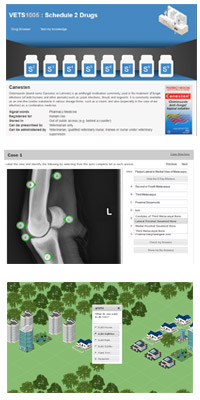Web Apps
What is it?
A web application is a website or tool that can be used to accomplish one or more tasks over the Internet. Not all websites can be considered a web application if all they do is provide information. A web application is something that may require you to log in and will remember your last visit. It can provide users with instant feedback (both text and visual) based on their interactions which has unlimited potential in eLearning. Web applications can be freely access online or custom made by a developer using browser technologies such as HTML5, CSS3, jQuery and PHP.
Who uses them at UQ?
The following are examples of custom made interactives developed for the University by a web developer.

- VETS1005 Drug Browser : shire.science.uq.edu.au/vets1005/
The Drug browser lets students have a closer look at the labelling and packaging of a range of drugs from the chemists shelf to restricted poisons. Students can also test their knowledge by answering some questions when they're ready. - Radiographic Anatomy of a Horse : shire.science.uq.edu.au/xray/case.php?c=1&s=1
Developed as the first in a series of case studies for Veterinary Radiology, this application requires the student to practice identifying views and objects in xrays. To assist the students an auto-complete script has been used to remove spelling as an inhibitor to learning the basics. - Town Planner Experiment : shire.science.uq.edu.au/showcase/town-planner/
In proposal stage only, this application is a proof of concept of how location based learning activities such as agriculture and farming can be devloped using an isometric style. The next stage of development is to enable areas of influence around specific objects on the map. For example, a refuse station next to residential buildings would have various consequences. - Evolution Timeline Experiment : shire.science.uq.edu.au/showcase/evolution/
To get a better idea of linked events that occur over a period of time this proof of concept using an evolution image shows how you can provide contextual information while engaging the user with interactivity.
What else is possible?
Below is a list of some potentially useful shared web applications that are freely available to use on the Internet.
- Chemical Elements : biocourseware.com/iphone/elements/
A free elegant chemistry tool for students and researchers. It offers an elements’ list view and periodic table view. All elements are given with its properties and images. Users can even try the molecular weight calculator. - Genetic Decoder : biocourseware.com/iphone/genecode/
A handy genetic code converter for students and researchers in biological sciences. Simply click to change DNA or RNA codons and related amino acid information will be displayed. User also can browse information by selecting an amino acid from the list. - Cal Concentration : biocourseware.com/iphone/conc/
A handy calculator for preparing solutions and buffers. Calculate how many solutes are needed to get the target concentration (w/v, v/v, molarity or dilution) - Vision Objects Demonstrations : webdemo.visionobjects.com
Vision Objects have a collection of touch screen friendly web applications for drawing and can convert handwriting to text and solve equations. - Embedr : embedr.com
Embedr is a free service that lets anyone create a custom playlist of videos from video sites on the web. - PodOmatic : podomatic.com
PodOmatic is an extraordinarily easy way to create a podcast. Sign-up and your class has your own channel - all you need is a computer microphone. - MapBuzz : mapbuzz.com
MapBuzz is an excellent map making web application that allows you to place 'Markers' or 'push-pins' to indicate places and events with additional text and images.